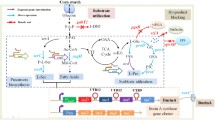Abstract
In this study, we utilized a catabolite repressor to improve the enzymatic activity of recombinant β-galactosidase inclusion bodies (IBs) produced in Escherichia coli under the araBAD promoter system. Specifically, we employed methyl α-d-glucopyranoside (α-MG) to lower the transcription rate of the β-galactosidase structural gene. In deepwell microtiter plate and lab-scale fermentor culture systems, we demonstrated that the addition of α-MG after induction improved the specific β-galactosidase production, even though β-galactosidase was still produced as an IB. Particularly, the addition of 0.0025% α-MG led to the most significant increase in the specific activity of the β-galactosidase. Interestingly, the β-galactosidase IBs obtained in the presence of 0.0025% α-MG were more loosely packed, as determined by IB solubilization in guanidine hydrochloride solution. We propose that the reduced gene transcription rate was responsible for the increased specific β-galactosidase activity and the loose packing that characterized the IBs produced in the presence of α-MG. This principle could be applied throughout the enzyme bioprocessing industry in order to enhance the activity of aggregate-prone enzymes within IBs.





Similar content being viewed by others
References
Barríos-Rivera SJ, Yang Y-T, Bennett GN, San K-Y (2000) Effect of glucose analog spplementation on metabolic flux distribution in ananerobic chemostat cultures of Escherichia coli. Metabolic Eng 2:149–154
Capelle MAH, Gurny R, Arvinte T (2007) High throughput screening of protein formulation stability: practical considerations. Eur J Pharm Biopharm 65:131–148
Carrió M, González-Montalbán N, Vera A, Villaverde A, Ventura S (2005) Amyloid-like properties of bacterial inclusion bodies. J Mol Biol 347:1025–1037
Chou C-H, Bennett GN, San K-Y (1994) Effect of modulated glucose uptake on high-level recombinant protein production in a dense Escherichia coli culture. Biotechnol Prog 10:644–647
de Groot NS, Ventura S (2006) Effect of temperature on protein quality in bacterial inclusion bodies. FEBS Lett 580:6471–6476
de Groot NS, Ventura S (2006) Protein activity in bacterial inclusion bodies correlates with predicted aggregation rates. J Biotechnol 125:110–113
Duetz WA, Rüedi L, Hermann R, O’Connor K, Büchs J, Witholt B (2000) Methods for intense aeration, growth, storage, and replication of bacterial strains in microtiter plates. Appl Environ Micorbiol 66:2641–2646
Garcia-Fruitos E, Carrio MM, Aris A, Villaverde A (2005) Folding of a misfolding-prone β-galactosidase in absence of DnaK. Biotechnol Bioeng 90:869–875
García-Fruitós E, González-Montalbán N, Morell M, Vera A, Ferraz RM, Arís A, Ventura S, Villaverde A (2005) Aggregation as bacterial inclusion bodies does not imply inactivation of enzymes and fluorescent proteins. Microb Cell Fact 4:27
García-Fruitós E, Martínez-Alonso M, Gonzàlez-Montalbán N, Valli M, Mattanovich D, Villaverde A (2007) Divergent genetic control of protein solubility and conformational quality in Escherichia coli. J Mol Biol 374:195–205
González-Montalbán N, García-Fruitós E, Villaverde A (2007) Recombinant protein solubility—does more mean better? Nature Biotechnol 718–720
Jevsevar S, Gaberc-Porekar V, Fonda I, Podobnik B, Grdadolnik J, Menart V (2005) Production of nonclassical inclusion bodies from which correctly folded protein can be extracted. Biotechnol Prog 21:632–639
Jung K-H (2008) Enhanced enzyme activities of inclusion bodies of recombinant β-galactosidase via the addition of inducer analog after l-arabinose induction in the araBAD promoter system of Escherichia coli. J Microbiol Biotechnol (in press)
Lee Y-J, Jung K-H (2007) Modulation of the tendency towards inclusion body formation of recombinant protein by the addition of glucose in the araBAD promoter system of Escherichia coli. J Microbiol Biotechnol 17:1898–1903
Lichenstein HS, Hamilton EP, Lee N (1987) Repression and catabolite gene activation in the araBAD operon. J Bacteriol 169:811–822
Martínez-Alonso M, Vera A, Villaverde A (2007) Role of the chaperone DnaK in protein solubility and conformational quality in inclusion body-forming Escherichia coli cells. FEMS Microbiol Lett 273:187–195
Miller JM (1973) Experiments in molecular genetics. Cold Spring Harbor Laboratory Press, New York
Miller JM (2001) Time course assay of β-galactosidase. In: Hardin C, Edwards J, Riell A, Presutti D, Miller W, Robertson D (eds) Cloning, gene expression, and protein purification. Experimental procedures and process rationale. Oxford University Press, Oxford, pp 292–293
Schleif R (2000) Regulation of the l-arabinose operon of Escherichia coli. Trends Genet 16:559–565
Smith AM, Chan J, Oksenberg D, Urfer R, Wexler DS, Ow A, Gao L, McAlorum A, Huang SG (2004) A high-throughput turbidometric assay for screening inhibitors of protein disulfide isomerase activity. J Biomol Screen 9:614–620
Sørensen HP, Mortensen KK (2005) Advanced genetic strategies for recombinant protein expression in Escherichia coli. J Biotechnol 115:113–128
Tokatlidis K, Dhurjati P, Millet J, Béguin P, Aubert JP (1991) High activity of inclusion bodies formed in Escherichia coli overproducing Clostridium thermocellum endoglucanase D. FEBS Lett 282:205–208
van den Berg B, Ellis RJ, Dobson CM (1999) Effects of macromolecular crowding on protein folding and aggregation. EMBO J 18:6927–6933
Ventura S, Villaverde A (2006) Protein quality in bacterial inclusion bodies. Trends Biotechnol 24:179–185
Vera A, González-Montalbán N, Arís A, Villaverde A (2007) The conformational quality of insoluble recombinant proteins is enhanced at low growth temperatures. Biotechnol Bioeng 96:1101–1106
Worrall DM, Goss NH (1989) The formation of biologically active β-galactosidase inclusion bodies in Escherichia coli. Aust J Biotechnol 3:28–32
Zhang X, Schleif R (1989) Catabolite gene activator protein mutations affecting activity of the araBAD promoter. J Bacteriol 180:195–200
Acknowledgments
This work was supported by the Korea Research Foundation Grant funded by the Korean Government (MOEHRD, Basic Research Promotion Fund) (KRF-2006-331-D00174). The author thanks Mr. Sung Hun Kim for his technical assistance.
Author information
Authors and Affiliations
Corresponding author
Rights and permissions
About this article
Cite this article
Jung, KH., Yeon, JH., Moon, SK. et al. Methyl α-d-glucopyranoside enhances the enzymatic activity of recombinant β-galactosidase inclusion bodies in the araBAD promoter system of Escherichia coli . J Ind Microbiol Biotechnol 35, 695–701 (2008). https://doi.org/10.1007/s10295-008-0329-6
Received:
Accepted:
Published:
Issue Date:
DOI: https://doi.org/10.1007/s10295-008-0329-6




